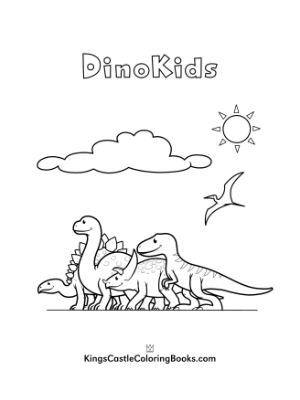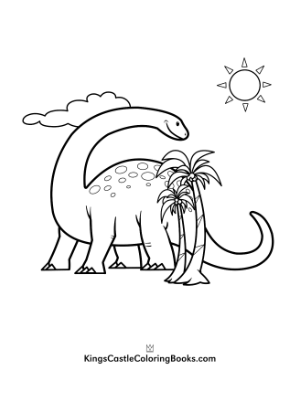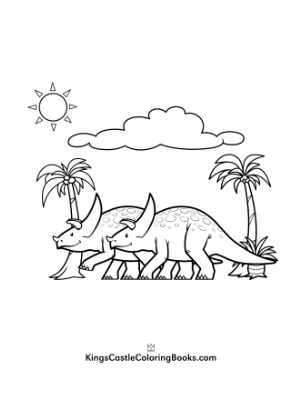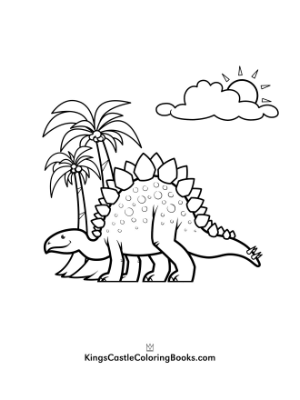Dinosaur Coloring Page
printable Downloads
Welcome to the Dinosaur Petting Zoo - the place to get your Free Dinosaur Coloring Page Printable Downloads!
|
We hope you enjoy these Free |
Dinosaurs were giant monsters spawned from the primordial ooze of an ancient jungle-world millions of years ago.
Dinosaurs were famous for their ravenous appetites and for smashing everything around them all the time!
|
But these are DinoKids! They are smaller, cuter, harmlesser versions of their vicious parents. Ready to start coloring? |
Dinosaur coloring pages
|
If you prefer to collect all 12 DinoKids in digital form, As soon as you order, you can download and print as many pages you need to satisfy the endless color combination possibilities adorable dinosaurs may have been! |
DinoKids Coloring Book!
|
We think the best way to collect them all is to get 12 fun DinoKids just like the Printable Download Version, Order one or more today! |
Play the video to see the whole book!
Did you know...?
there’s a lot to know about dinosaurs!
When we think of animals, it's pretty obvious there are many different kinds of animals.
But when scientists study animals, they are trying to understand all these different kinds of animals.
In science, every little detail must be specified, classified, and codified. Therefore, the study of animals is a mighty complicated business. This holds true for common pets and wild animals alike - but especially so when it comes to strange animals that disappeared millions of years ago!
All Dinosaurs are prehistoric animals - but not all prehistoric animals are Dinosaurs!
Scientists break the ancient world up into separate time eras, which are further broken down into time periods.
Part of the reason they do this is because only certain kinds of plants and animals existed during certain eras and periods.
It takes a long time to make a dinosaur!
Six hundred million years ago, there was water. Lots of water. This was the Proterozoic era.
Microscopic life thrived in the Proterozoic water for one hundred million years until, somehow, the tiny, simple celled
organisms found they were sharing their soggy world with more complicated animals and aquatic plants.
Scientists call this the Paleozoic era.
The Paleozoic era includes the Permian period, a time when land rose out of the water to host
a world of remarkable animals of all shapes and sizes - but none of them were Dinosaurs.
A classic example of of these interesting animals is the famous Dimetrodon, a large reptile with a huge
spiny sail on its back. Most folks think of this animal as a Dinosaur, but it is not a Dinosaur.
Scientifically speaking, it's a Synapsid or "mammal-like reptile". There's nothing wrong with thinking
that a Dimetrodon is a Dinosaur. But, FYI, it's not!
Things were going fine for Dimetrodon and all the other wondrous animals for over two hundred and fifty
million years until a strange twist of fate changed everything.
Many of the Permian animals disappeared as new creatures mysteriously showed up in the world.
The Paleozoic era gave way to the Mesozoic era - a.k.a. the world of Dinosaurs!
When dinosaurs ruled...
Countless Dinosaurs lived through the Mesozoic era, which lasted over one hundred and fifty million years.
But not all of them lived at the same time.
The Mesozoic era is broken up into three periods. The Triassic, the Jurassic, and the Cretaceous.
The Triassic period was a time when Dinosaurs, in their many forms, began outnumbering the other weird animals
that took over the land previously. There were many kinds of Dinosaurs. Scientists break them up in two groups,
Saurischia and Ornithischia. But there are a whole bunch of different kinds of Dinosaurs in each group.
Most people think of Dinosaurs as giants. Indeed there were lots of giant Dinosaurs, but most of the Triassic Dinosaurs
were not particularly huge. In fact, hardly any of the big and famous Dinosaurs come from the Triassic period.
Triassic dinosaurs
Herrerasaurus was a hunter in the Triassic forests of the ancient world.
This animal was about the size of a crocodile, but unlike a crocodile, Herrerasaurus stood up straight on long legs.
This is one of the defining characteristics of all Dinosaurs. Whether they walked around on two legs or all four,
their limbs were long, powerful and well designed to support their weight constantly.
This was the biggest difference between them and all the other interesting animals that came before them.
|
Don't forget to grab your |
Herrerasaurus was just one of a new breed of predators that could run very fast on two legs
and catch prey with long, curved, pointy teeth and claws.
There were other predators, like Eoraptor and Coelophysis, that were not quite as big, but just as quick and mean.
Another kind of Dinosaur that lived during the Triassic period was a plant eater called Plateosaurus.
This animal was much bigger than the predatory Dinosaurs and was one of the first dinosaurs ever found.
Animals like Plateosaurus were different from the predatory Dinosaurs in many ways,
but its long, robust legs are what scientists agree make it a Dinosaur,
as opposed to the other kinds of creatures that would disappear at the end of the Triassic period.
the real Jurassic park
Dinosaurs got really big during the Jurassic period - literally and figuratively.
Most of the famous Dinosaurs you've heard of showed up in Jurassic times.
There were still plenty of small Dinosaurs scurrying around, but this is when the world of Dinosaurs
we typically think of really got going. When Dinosaurs finally became the gigantic creatures we're
all familiar with.
Hunting Dinosaurs like Allosaurus, Ceratosaurus, and Megalosaurus were even more scary than their Triassic predecessors.
These newJurassic predators grew up to about the size of elephants!
Stegosaurus and Kentrosaurus were examples of other new Dinosaurs that reached outrageous proportions.
Even though they were vegetarians, they could be quite dangerous with their huge boney plates,
spines, and horns growing from various parts of their bodies.
Hunting Dinosaurs would have to be quick and tough in order to go after them!
But when it's time to talk about really big, it's time to talk about the Jurassic Sauropod Dinosaurs!
|
Collect all four |
Famous Sauropods like Diplodocus, Brachiosaurus and Apatosaurus made elephants seem small compared to
their astonishing bulk! They looked down on the world from their long necks that reached up into the sky!
The most famous Sauropod, one of the most famous Dinosaurs of all time; is known as Brontosaurus.
There's only one problem. There's no such animal.
Brontosaurus was the name given to a fossil skeleton that turned out to have already been named Apatosaurus.
Brontosaurus was getting all the attention for years until scientists recognized their mistake.
To this day, Brontosaurus is still getting all the attention. There's nothing wrong with thinking Brontosaurus
was a real Dinosaur. But, scientifically speaking, it's just a cartoon character!
Also common in the Jurassic period were Pterosaurs, the "flying reptiles" like Pterodactyl, Rhamphorhynchus,
and Dimorphodon. However, while most scientists agree these winged creatures were related to Dinosaurs,
they also agree that they are decidedly not Dinosaurs. There's nothing wrong with thinking that Pterosaurs
are Dinosaurs. But, scientifically speaking, they are not the same.

|
Don't forget to grab your |






